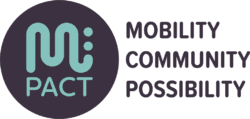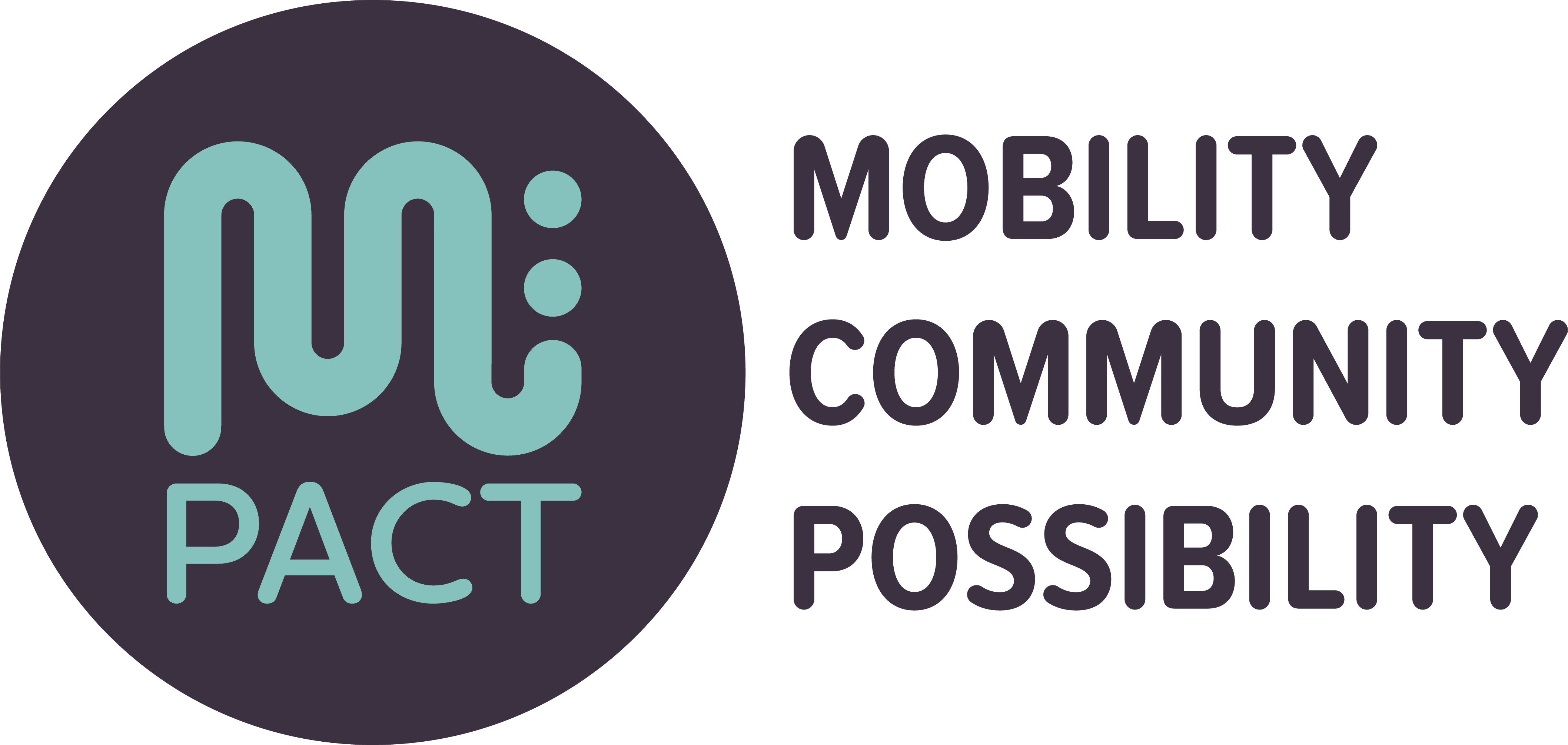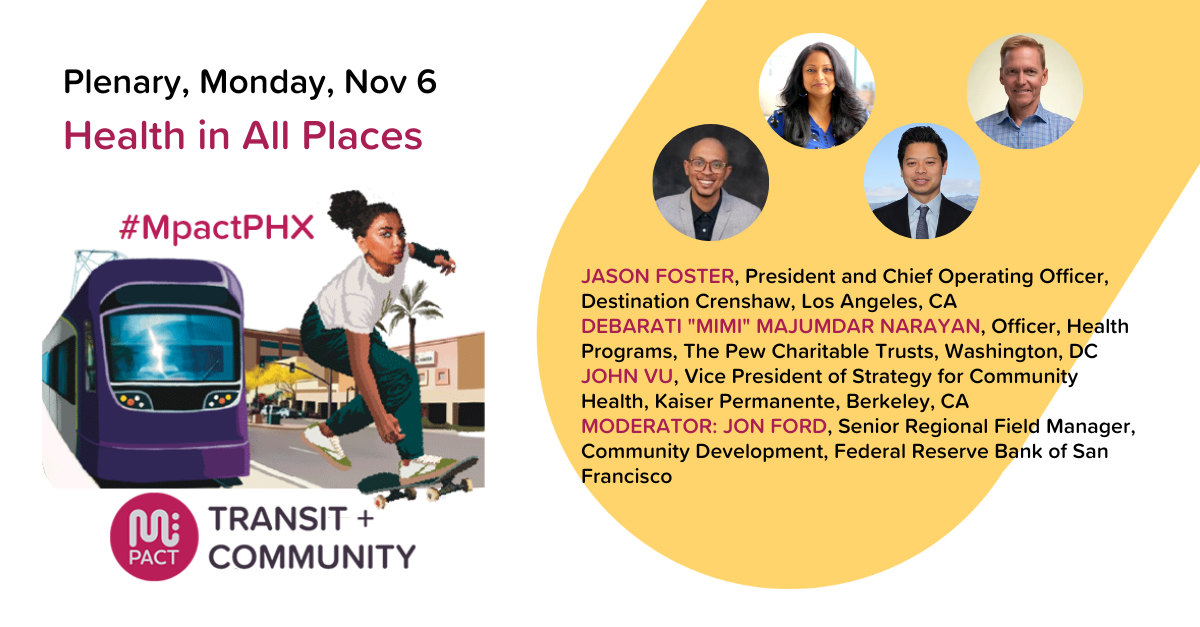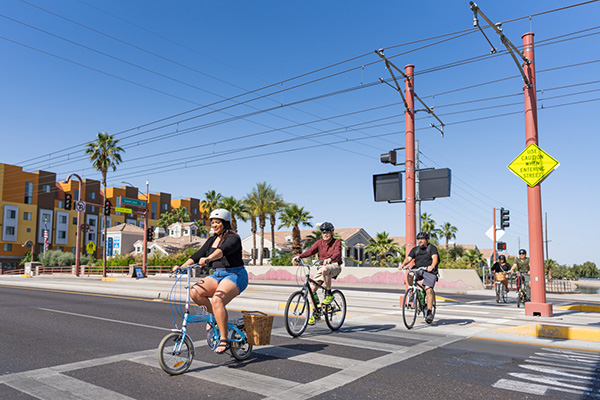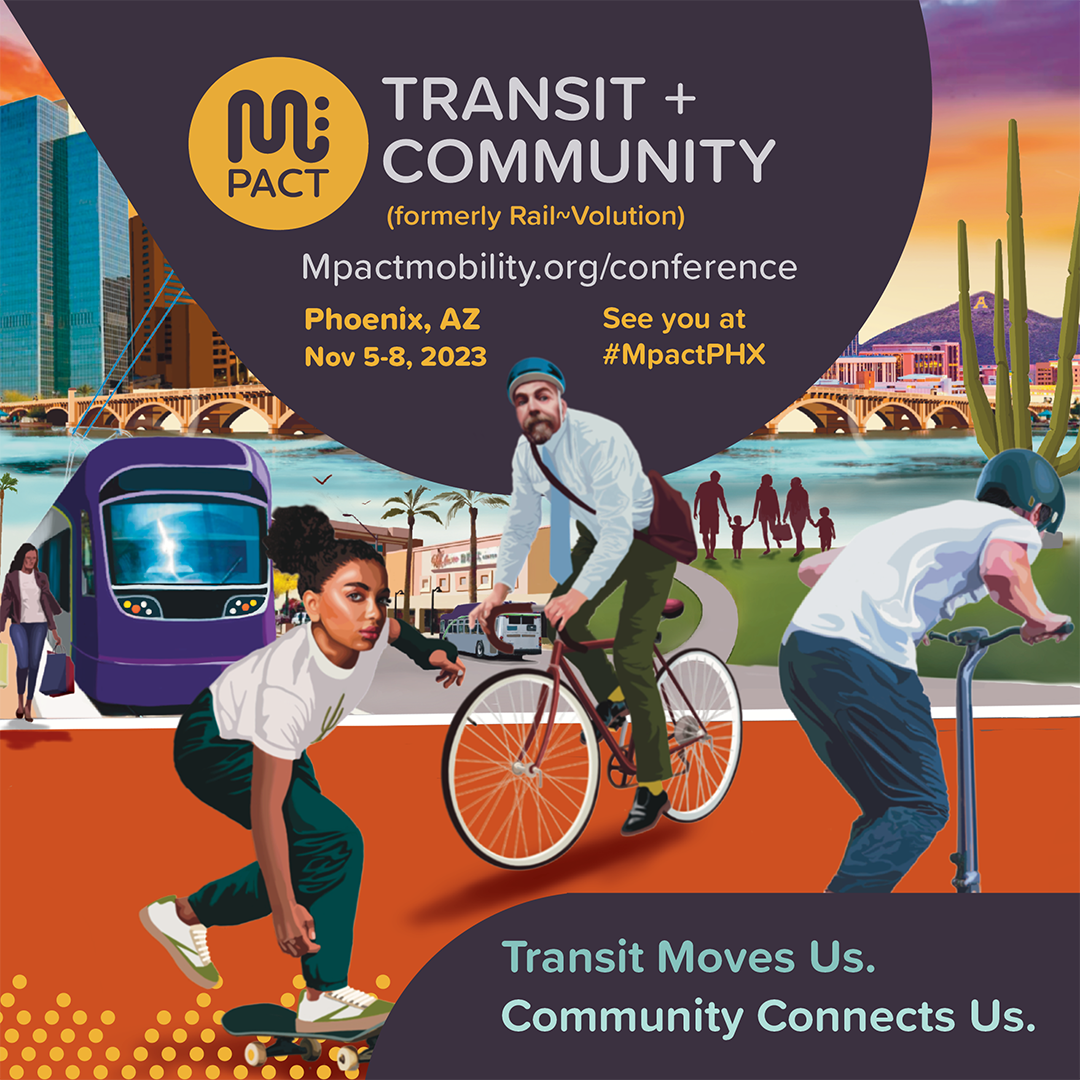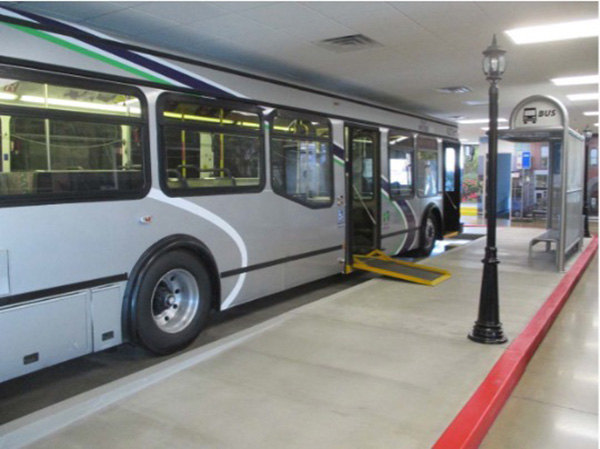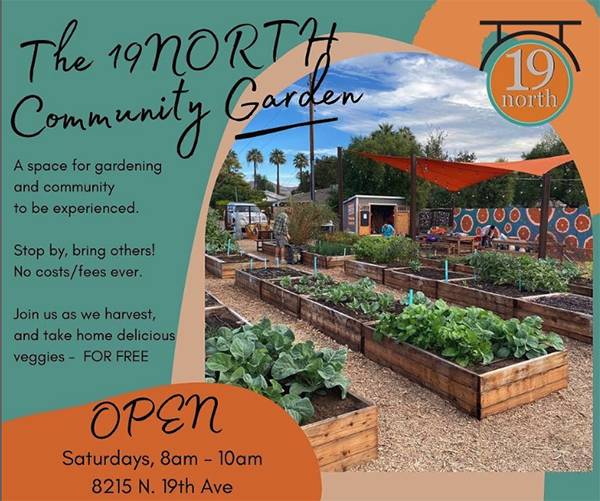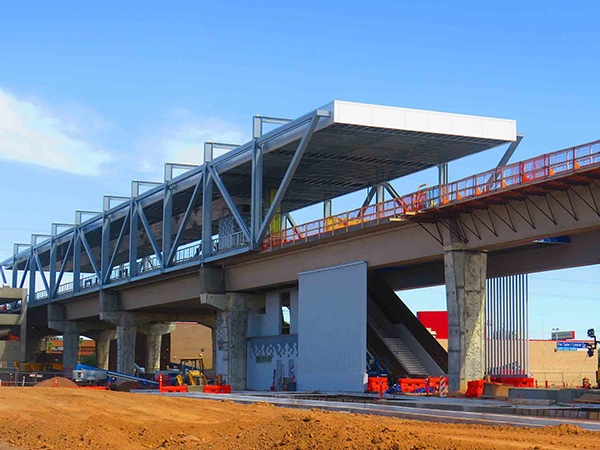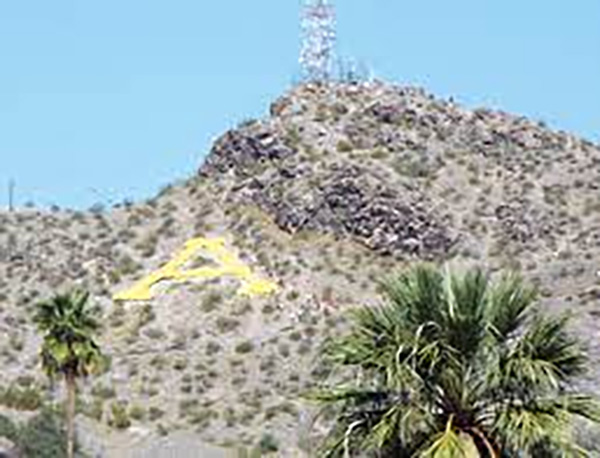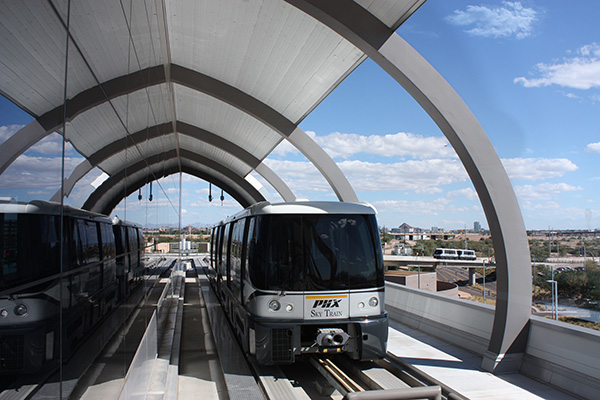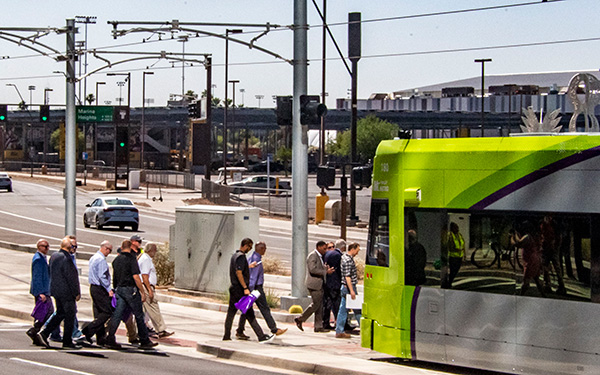Plenaries
Opening Plenary – Health in All Places
Phoenix Ballroom, 3rd Level
Welcome
Darryl Slim, Diné Wellness Educator, Mesa, AZ
Jessica Mefford-Miller, Chief Executive Officer, Valley Metro, Phoenix, AZ
Closing Remarks
Kate Gallego, Mayor, City of Phoenix, AZ
Plenary – Health in All Places
We all know that walkable, transit-oriented communities are healthier. They’re places where people can more easily and affordably get to jobs, education, fresh food, recreation and doctor’s appointments. There’s less stress, more social interaction and physical activity as well as lower generation of and exposure to emissions. But how can the links between health, transit and community development be strengthened, to make these communities a reality for more people?
Let’s explore promising partnerships among healthcare, government, philanthropy and community development organizations – and some case studies from around the country. In Phoenix, healthcare institutions have worked together to fund affordable housing around transit. In Los Angeles, Destination Crenshaw is leading the community’s effort to remake Crenshaw Boulevard, bringing art, jobs, pocket parks and small business support. It’s one of the largest reparative Black art and economic revival programs in the country. What’s the story behind these examples? Find out how a “health in all policies” approach shapes transit-oriented communities. Hear how Health Impact Assessments and other practical tools can guide decision-making around transit and open up unexpected sources of funding. The story is not only about high-level partnerships. It’s also about the role of community engagement and activism in shaping a healthy and equitable approach.
Moderator: Jon Ford, Senior Regional Field Manager, Community Development, Federal Reserve Bank of San Francisco, San Francisco, CA
Jason Foster, President and Chief Operating Officer, Destination Crenshaw, Los Angeles, CA
Debarati “Mimi” Majumdar Narayan, Ph.D., Officer, Health Programs, Pew Charitable Trusts, Washington, DC
John Vu, Vice President of Strategy for Community Health, Kaiser Permanente, Berkeley, CA
Affordable Housing, Economic Development, Health, Community Engagement, Transit.
Mobile Workshop
MW04 Grand Canal Multi-Use Trail
$65
You’ve heard of rail to trail, how about canal path to trail? The Phoenix metro area has 180 miles of canals, more than Venice and Amsterdam combined. Learn how the Grand Canalscape project converted the under-used utility corridor along one segment of canal into an attractive, vibrant and well-utilized community asset – one of the longest multi-use urban trail corridors in the state. Dig into the design details of the numerous at-grade bike/ped crossings where the canal intersects major arterials. As you ride the LRT and bike along the path, get an overview of the history and maintenance of the canals as well as of the multiple-use agreements with the Salt River Project, which manages the canals. You’ll take home fresh ideas about the under-used utility corridors waiting for transformation in your community!
Bicycling, Walking, Trail-Oriented Development, Street Design.
Mobile Workshop
MW05 Phoenix Streets: Historical Streetcar to Shared Micromobility
$45
In the first half of the twentieth century, streetcars were an integral part of Phoenix streets. Thirty miles of tracks carried 6 million riders a year. In 1947 a trolley bar fire destroyed most of the fleet and ushered in the era of buses – and cars. Fast forward to today. Hear from a bicycle advocate about the addition of bicycle facilities on Phoenix streets. Learn about the plans to bring new micromobility programs to the City of Phoenix. In 2015, voters approved Proposition 104, creating a 35-year street and transit plan with BRT as a key component. Spin over to the Trolley Museum to explore the vehicles of the past while you learn about today’s plans for multimodal streets.
Mobile Workshop
MW06 Car-Free Arizona: Achieving Sustainable Dreams at Culdesac
$65 (includes lunch)
Yes, Arizona is home to the first car-free community built from scratch in the US: Culdesac Tempe. Take a look around. Learn how this mixed-use neighborhood came to be approved in Tempe, about its design, how it is managed and sense of place. Fifty-five percent of the neighborhood is open space and it includes a grocery store, coffee shop, restaurant, bike shop, and coworking space. It’s a community designed around modern mobility, with e-bike garages, over 1,000 bike racks, on-site EV carshare, scooter parking and rideshare pick-up zones. All residents recieve $3,000/year in mobility benefits through a one-of-a-kind partnership with Lyft, Bird, Envoy, and Valley Metro. Go deeper with Culdesac staff, the design team and city staff into these and other details: the development structure, architecture and landscape architecture, heat mitigation, connections to existing neighborhoods and sustainability goals. Culdesac’s developers estimate that residents will emit 50% less transportation-related CO₂ emissions than their neighbors.
Mixed-Use Development, Electric Vehicles, 2023 Conference, Bicycling, Transit, Climate Resilience.
Session
Reimagining Arterials: The Next Big Thing in TOD
Ahwatukee, 2nd Level
Just about every North American city has fading, car-centric arterial corridors. At Rail~Volution 2019, Peter Calthorpe presented these corridors as the “next big idea” for TOD. How? By converting excess lane capacity to fixed guideways for transit. And converting commercial strip malls and expansive surface parking into TODs. In our current era of online shopping and work-from-home, this big idea is even more powerful. Where is it happening? Take a look at examples of TOD planning for rail and BRT along iconic radial arterials in four locations. Take home strategic lessons about market limitations, how to choose corridors for targeting regional growth and mitigating sprawl, and the role of anchor destinations, such as universities or suburban downtowns. We’ll also include a reality check: can this big idea shift trips and lower carbon emissions?
Moderator: Sasha Page, Principal, Rebel, Washington, DC
Sharla Horton-Williams, Board Member, Trinity Metro, Fort Worth, TX
Tobe Holmes, AICP, Senior Project Manager, WithersRavenel, Charlotte, NC
Debra Salon, PhD, Associate Professor, School of Geographical Sciences and Urban Planning, Arizona State University, Tempe, AZ
Session
Form or Finance: Making the Missing Middle Work
Encanto B, 2nd Level
The term “missing middle” describes housing types that have been excluded from many zoning codes. Advocates and planners blame such restrictive zoning for a lack of diverse housing – and for contributing to our national housing crisis. They call for zoning reform to remove restrictive, monotype districts and increase housing supply. Together, let’s explore the role zoning can play in mitigating the shortage of housing, particularly affordable and workforce. We’ll discuss the tools developers and planners need to create diverse housing options for a wide range of residents. What will be the next evolution of housing policy and the next step toward addressing the housing crisis? Let’s bring what’s out of the zone into the conversation!
Moderator: Cameran Bailey, Director of Development, Resilient Community Development Strategist, NEOO Partners, Inc., St. Paul, MN
Karen Parolek, President, Opticos Design, Inc., Berkeley, CA
Ryan Spak, Principal/Founder, Spak Group, Philadelphia, PA
Danielle Arigoni, Managing Director for Policy and Solutions, National Housing Trust, Washington, DC
Session
Ice and Fire: Landscapes for Climate Resilience
Maryvale B, 2nd Level
Imagine the Iron Throne (yes, a Game of Thrones reference) as a park bench in Phoenix or Calgary. Depending on the season, anyone who takes a seat could burn their skin or be frozen to the metal. Humor aside, our planet’s climate emergency demands serious action. Fortunately, there are practical urban design measures that effectively mitigate unpredictable heat, cold, wind and rain. These design choices also can strengthen communities, support transit users and offer more than just shelter. Join us for a dialog that meets the climate emergency with both intensity and inspiration. Short presentations on landscape design approaches to mitigate climate extremes followed by interactive conversation. You’ll learn about trees and plantings, shade and rain protection devices, the role of color and materials selection, wind screens, nighttime and cold weather considerations, plus examples of implementation at transit stations.
Nicole Rodriguez, Board Member, Trees Matter, Phoenix, AZ
Jay Hicks, FASLA, Principal, Dig Studio, Phoenix, Arizona
James (Jim) Hencke, ASLA, LEED AP, Design Studio Leader, David Evans and Associates, Inc, Portland, OR
J Ryan Wallace, AICP, AIA, NCARB, LEED GA, Principal, Urban Design, MHTN Architects, Salt Lake City, UT
Session
A Coalition Approach to Equitable Transit
Maryvale A, 2nd Level
How do we achieve the ultimate goal: transit expansion and related development that happens for and with communities instead of to them? Coalitions in Phoenix and Buffalo have organized to do just this. The Phoenix collaborative, with 50+ partners, connects and empowers dozens of leaders and community members from three distinct, culturally rich areas across the Phoenix South Central Corridor, where a light rail extension is under construction. In Buffalo, a multimodal, cross-sector partnership formed a wider coalition of committed citizens to support equitable transit-oriented development in the Buffalo region and along its Metro Rail Expansion corridor. Their work provides models for creating systems change, building capacity in under-served communities and securing broader benefits from transit projects and related transit-oriented development (TOD) plans.
Moderator: Shannon Scutari, President and Chief Executive Officer, Scutari & Company, LLC, Phoenix, AZ
Francisca Montoya, Director, Innovative Economic Solutions, Raza Development Fund, Phoenix, AZ
Victor Vidales, Realtor/Developer/Founding Member, SoPho Convening, Phoenix, AZ
Fred Frank, Lead Planner, WSP USA, Charlotte, NC
Ashley Smith, Assistant Manager of Government Relations and Development, Niagara Frontier Transportation Authority (NFTA), Buffalo, NY
Community Benefit Agreements, Community Development, Community Engagement, Capacity Building, Transit-Oriented Development (TOD).
Session
TOD to TOC: From the Ground Up
Cave Creek, 3rd Level
Let’s demystify TOD (transit-oriented development) in order to get better TOC (transit-oriented communities). Join with industry veterans to learn the foundational elements of TOC. Get into the implications: for ridership, parking, placemaking, equity and more. Find out how one legacy transit system is building on best practices of long-established TOD programs to push forward our understanding of successful, equitable TOC. Although TOC looks different in every community, this session will explore ways to understand successful transit-oriented development within different contexts and demystify the most efficient path forward.
Moderator: Amy Yoder, Planner, Transit-Oriented Development, Metro Transit, Minneapolis, MN
Chessy Brady, AICP, Transit-Oriented Development Manager, Regional Transportation District (RTD), Denver, CO
Jennifer Dougherty, AICP, Manager, Long-Range Planning, Southeastern Pennsylvania Transportation Authority (SEPTA), Philadelphia, PA
Session
Transit Agency CEOs: Circling Back and Looking Forward
Encanto A, 2nd Level
Transit agencies are in transition, adapting furiously to meet changing realities. Have we reached equilibrium or are we still in transition? What does the new normal look like? Will people working from home return to the office – for which days? If downtowns are not so core, what are key destinations and travel patterns? How are agencies rethinking service delivery, capital project funding and customer service? What’s their role in social issues? Come hear transit agency leaders – some of whom were new when COVID hit – discuss their approach to this new transit environment, lessons learned and what they’re doing to meet challenges head-on.
Moderator: Diana Mendes, AICP, Corporate President, Infrastructure and Mobility Equity, HNTB Corporation, Arlington, VA
April Chan, General Manager and Chief Executive Officer, San Mateo County Transit District (SamTrans), San Carlos, CA
Nadine Lee, President and Chief Executive Officer, Dallas Area Rapid Transit (DART), Dallas, TX
Jessica Mefford-Miller, Chief Executive Officer, Valley Metro, Phoenix, AZ
Bob Powers, PE, President and Chief Executive Officer, San Francisco Bay Area Rapid Transit District (BART), Oakland, CA
Frank White III, Chief Executive Officer, Kansas City Area Transportation Authority, Kansas City, MO
Session
Lasso that Money! The Basics of Funding
Laveen, 2nd Level
You’ve got an amazing project. The public loves it, stakeholders are on board and the agency can’t wait to break ground. But how do you pay for it? As Ted Lasso would say, “The harder you work, the luckier you get.” Together, we’ll dive into the differences between funding and financing, explore capital and operating funding sources, discuss developing funding plans for all stages of project development and offer a few wise words from our favorite coach, Ted Lasso. “If the Lasso way is wrong, it’s hard to imagine being right.”
Facilitator: Tesse Rasmussen, Managing Principal, InfraStrategies LLC, El Segundo, CA
Amanda Vandegrift, Managing Principal, InfraStrategies LLC, Atlanta, GA
Manjiri Akalkotkar, AIA, Vice President, Program Delivery, VIA Metropolitan Transit Authority, San Antonio, TX
Session
Driven by Data: Unleashing the Potential of Rail Corridors
Estrella, 2nd Level
Maximizing the efficiency and potential of shared rail corridors – intercity, commuter and freight – is no easy task. Data can help. Let’s get into some specific examples. Caltrain is using an “Investment Sifting and Evaluation Toolkit” to evaluate different station redevelopment projects, providing baseline comparisons for a range of qualitative and quantitative metrics, from operations and economic factors to equity, climate resilience and urban design. Transforming Rail in Virginia (TRV) is using data to project travel demand and mode share as part of making decisions about capacity expansion in Richmond’s Shockoe Hill neighborhood, an area where an historical slave burial ground is now a significant cultural resource. These projects emphasize the role of effective data management in strategic planning and informed decision-making for shared rail corridors.
Moderator: Val Menotti, Chief Planning & Development Officer, San Francisco Bay Area Rapid Transit District (BART), Oakland, CA
Shruti Malik, Urban Planning and Mobility Practice Lead, Mott MacDonald, Oakland, CA
Dahlia Chazan, Deputy Chief – Caltrain Planning, Peninsula Corridor Joint Powers Board, Caltrain, Berkeley, CA
Paul Lewis, Principal, DB Engineering & Consulting USA, Inc., Washington, DC
Transportation Demand Management, Design, Equity, Climate Resilience, Corridor Planning, Data.
Mobile Workshop
MW07 Take a “Transit Walk” at the Mobility Center
$65 (includes lunch)
Valley Metro’s Mobility Center provides several services for customers with specialized mobility needs, from ADA certification to fixed-route travel training to information about fare pass programs. It’s a state-of-the-art, multifunctional facility that simulates the look and feel of the public transit system. Take a “transit walk” through a simulated streetscape in an indoor environment, featuring a street crossing with curb cuts, a pedestrian activated street signal, a bus stop and shelter, a light rail station and a Valley Metro bus. Learn how Valley Metro’s customers use the facility: to experience the accessibility of Valley Metro buses and trains in a safe and controlled setting. For Valley Metro staff, the transit environment provides an opportunity to accurately evaluate whether buses and trains can accommodate the specific needs of each customer who applies to use ADA Paratransit service and determine if travel training might be a viable option.
Mobile Workshop
MW08 Cultivating Community: An Urban Garden Hub on the LRT
$65 (includes lunch)
We all know transit connects communities. But let’s take a close look at two urban gardens on light rail that serve as community hubs. CamelBackyard is an urban farm that grows organic produce through an aquaponics greenhouse and offers raised beds for community members, along with space to wash and process produce, a shaded outdoor classroom and an adjacent community kitchen with a refrigerator for food storage. The site serves as the pick-up location for community supported agriculture boxes from farmers located across the Valley. CamelBackyard is operated by the International Rescue Committee, an international aid and refugee resettlement agency, through its New Roots Program. Hear from the program coordinator and talk with clients involved with the program. Then hop back on the LRT to 19th North Community Garden. Supported by neighborhood leaders and residents, the garden welcomes everyone to join in the joy of gardening and harvesting and to share the bounty that results.
Networking
Mpact Innovators Presents: Walking Tour – From One-N-Ten to Margaret T. Hance Park
Join us and walk away with a deeper understanding of Phoenix’s past, present and future. Ride light rail to One-N-Ten, a nonprofit organization that is dedicated to serving and assisting LGBTQIA+ youth and that offers a safe space for youth of all socio-economic and cultural backgrounds. Then visit nearby Margaret T. Hance Park, 32 acres of green space built over the I-10 freeway tunnel. This interstate capping project is a sterling example of how cities can reclaim and reutilize public space. Stroll through the park and explore its unique attractions – Japanese Friendship Garden, Irish Cultural Center, McClelland Irish Library, Phoenix Center for the Arts and Burton Barr Phoenix Central Library – each of which tells a story about Phoenix’s rich cultural diversity and commitment to arts and learning.
Facilitator: John Heaton IV, Sustainable Transportation Planner, WSP USA, New York, NY
Networking
Mpact Innovators Presents: Walking Tour – Urban Transformation in the Taylor Paseo District
Join this lunch time walk for a firsthand look at urban transformation in downtown Phoenix, from skyline to streetscape. Visit a downtown park – a public oasis. Find out how the YMCA is providing heat relief, daycare and transitional housing. Learn about the city’s Paseo plan, which is fostering connectivity and accessibility by breaking down large blocks into more walkable and amiable spaces. Hear about affordable senior housing initiatives. Check out new bike lanes and scramble crosswalks. It’s all part of the city’s ongoing efforts to transform Phoenix into a city that truly puts its people first.
Facilitator: Jamie Trufin, Business Development Coordinator, Downtown Phoenix Inc, Phoenix, AZ
Mobile Workshop
MW09 Central Station Phoenix Redevelopment: A Hard Hat View
$45
Central Station has been the heart of the Phoenix regional transit system since the late 1990s, but the arrival of light rail in 2008 sparked a new vision for a transit center integrated with housing, retail and adjacent green space. That vision is coming to reality with the Central Station Redevelopment Project, currently under construction. Take a hard hat tour of the site. Hear from city staff and the project’s developer about the 1 million square foot, two tower, mixed-use development with a reconstructed transit center. Learn about the history of the project, the business agreements and intergovernmental cooperation involved and the ways that layout and design foster a more livable built environment in harmony with nature. Slated to open in 2025, Central Station will be home to more than 1,000 residents and set a new standard for sustainable development in Phoenix.
Mixed-Use Development, Project Management, Economic Development, Transit, Transit-Oriented Development (TOD).
Mobile Workshop
MW10 Extension to the Future: From 70s Mall to Walkable Urban Village
$45
Phoenix’s Metrocenter Mall, opened in the 1970s, was in its heyday one of the biggest and busiest malls in the US. Fast forward to the present to learn how the 1.6 mile Northwest Extension Phase II will leap over an Interstate highway to extend the reach of transit-oriented development. Hear from the developers who are transforming the mall into a walkable urban village, with multifamily units and commercial space. Explore – before the opening set for 2024 – the elevated light rail station with a bus transit center at the plaza level. Find out about innovative approaches to delivering this project and how Valley Metro is integrating artwork into three new stations. You’ll also hear from local leaders about how the community is planning to benefit from the redevelopment.
Public Art, Trail-Oriented Development, Economic Development.
Session
Supercharging Your Bus Network
Laveen, 2nd Level
Buses are the workhorses of most public transit systems and the COVID-19 pandemic cemented the critical importance of bus-based mobility in our communities. Programs to tackle chronic bus delay are delivering more reliable service, centering investment in equity-priority communities and delivering big benefits with small capital budgets. Learn the details from the US and Canada: How to use common transit agency data to dynamically illuminate the location, time and impacts of bus delay. How to select and implement bus priority treatments. How to communicate benefits and trade-offs in order to build support with staff and leadership. It’s all part of supercharging your bus network!
Moderator: Julianne Sabula, AICP, Deputy Director, Transportation, Salt Lake City, Utah, Salt Lake City, UT
Jonathan Mostiero, Associate Principal Planner, Nelson\Nygaard Consulting Associates, Inc., Denver, CO
Stephen Newhouse, Manager, Bus Speed and Reliability, TransLink, Vancouver, BC
Phoebe Fooks, City Planner – Transit, Department of Transportation, City and County of Denver, Denver, CO.
Andrew McFarland, Transit Priority Project Manager, Massachusetts Bay Transportation Authority (MBTA), Boston, MA
Session
Transit Stops: Unlocking the Potential
Ahwatukee, 2nd Level
Time to re-envision your humble transit stop. What would it take – what could be done – to transform the place you wait for the bus into a community asset? There are great stories to tell! Hear how placemaking and public art linked with community input and vision can seed creative interventions that make transit stops safer and more active, connecting them more strongly to neighborhood identity. Green space? A sense of play? An opportunity to mitigate long-standing inequities? Yes! Yes! Yes! Come and be energized by examples from across the country. Bring your ideas for transforming a “blank slate” transit stop. Come away with tools applicable to a variety of scales and types. Learn how to bring on collaborators and troubleshoot hurdles while keeping community and creativity at the core.
Moderator: Monica Carney-Holmes, Executive Manager, Corridors of Opportunity, City of Charlotte, Charlotte, NC
Kimberly Cella, FAIA, Executive Director, Citizens for Modern Transit, St. Louis, MO
Sheila Holm, Community Outreach Director, AARP St. Louis, St. Louis, MO
Jen Krava, Director of Programming + New Initiatives, Forecast, Saint Paul, MN
Session
The Power of Partnership to Address Homelessness
Encanto B
For people at risk of or experiencing homelessness, transit provides reliable, affordable rides to essential services. Many transit agencies collaborate with nonprofits to distribute free or reduced fare cards to people who are unhoused. During extreme weather, some transit agencies deploy vehicles as cooling or warming centers. Many transit agencies also have started scheduling outreach workers, navigators or ambassadors to engage with unhoused riders, providing access and referral to shelter, housing and health care. But given the scale of our nation’s homelessness crisis, we need to go deeper. The White House and the US Interagency Council on Homelessness (USICH) are responding to this crisis by launching ALL INside, a place-based initiative to reduce unsheltered homelessness. The Phoenix metro area is one of several cities selected to participate. ALL INside Phoenix is taking stock of effective practices so they can be iterated and scaled, and identifying barriers for federal, state and local partners to bust. Hear from the team doing this hard, important work.
Moderator: Joanne Waszczak, MSW, USDOT Liaison to USICH, Federal Transit Administration, US Department of Transportation, Washington, DC
Tamara Wright, Senior Regional Advisor, US Interagency Council on Homelessness (USICH), Phoenix, AZ
Katie Gentry, Regional Homelessness Program Manager, Maricopa Association of Governments, Phoenix, AZ
Markus Coleman, Light Rail Administrator, City of Phoenix Public Transit, Phoenix, AZ
Rachel Milne, Director, City of Phoenix Office of Homeless Solutions, Phoenix, AZ
Ollie Nyman, Associate Director of Housing & Community Integration, Community Bridges, Inc. (CBI), Phoenix, AZ
Eric Barr, Chief Executive Officer, ELAINE, Phoenix, AZ
Session
TOD Guidelines: What’s Working Best
Cave Creek, 3rd Level
Design guidelines exist along a spectrum, from high-level “aspirational” guidance to nuts-and-bolts “dimensional” guidance. Transit-oriented development (TOD) design guidelines, wherever they fall on the spectrum, can help provide more predictable and repeatable development outcomes along transit corridors. But not all agencies and local governments that operate transit use design guidelines. What does it take to create them? What elements are important to include and what are the pitfalls to avoid? Hear from speakers who have just created policies and others who have recently revised long-standing guidelines to incorporate lessons learned over the years. Get the full spectrum, with examples from communities across the US and Canada. Come away with an understanding of TOD guidelines, how they add value and their limitations.
Moderator: Katherine Howe, Principal, Perkins Eastman, Oakland, CA
Juan Calaf, Senior Land Use Planner, Sound Transit, Seattle, WA
Alex Sandoval, Senior Manager, Facilities Development Program, TransLink, Vancouver, BC
Shannon Dodge, Principal Property Development Officer, San Francisco Bay Area Rapid Transit (BART), Oakland, CA
Session
BRT 101: What You Need to Know Before You Start
Encanto A, 2nd Level
As the landscape for bus rapid transit (BRT) evolves, systems across the country are adjusting. With lower capital costs, enhanced services such as bus rapid transit and Better Bus applications have gained popularity. When integrating a high-capacity corridor into the built environment, there are many tools in the toolbox. Each project is unique, potentially involving a variety of customized applications. Together, we’ll unpack what factors to consider when developing a preferred alternative, how to prioritize BRT investments to serve the most people, how different methods of public engagement can inform and build support for a project, new innovations in design applications and policy, as well as ways to provide more equitable service.
Moderator: Tyler Besch, Vice President, Greater West & Gulf Coast Transit-Rail Division Manager, AECOM, Phoenix, AZ
Sara Kotecki, P.E., Bus Rapid Transit Administrator, City of Phoenix, Arizona, Phoenix, AZ
Amy Silbermann, AICP, Director of Planning & Service Development, Pittsburgh Regional Transit, Pittsburgh, PA
Yuhayna Mahmud, University BRT Project Manager, Metropolitan Transit Authority of Harris County (METRO), Houston, TX
Adam Smith, Manager, BRT Projects, Metro Transit, Minneapolis, MN
Session
Red Line Aftermath: How Baltimore Turned Cancellation Into Innovation
Maryvale A, 2nd Level
The Baltimore Red Line received almost a billion dollars in federal funding before it was abruptly canceled in 2015 by a newly-elected Governor. Magnified by an already-strained relationship with residents, this cancellation became a catalyst for intense analysis of the roles state and local stakeholders should play in transit governance and funding. Baltimore is the only large metropolitan agency in the nation whose transit system is operated by a state agency without the oversight of any board or commission, a structure that exacerbates a disconnect between transit and land use and hinders transit-oriented development. Hear the story of innovative governance strategies pursued by the Baltimore Metropolitan Council in the wake of the Red Line’s cancellation. Learn how they successfully crafted and passed a new governance structure, an essential step toward the goal of a more transparent, efficient and equitable transit system that works for all residents of the region.
Moderator: Michael Kelly, Executive Director, Baltimore Metropolitan Council, Baltimore, MD
Tony Bridges, Assistant Secretary, Transportation Equity and Engagement, Maryland Department of Transportation, Baltimore, MD
Steuart Pittman, County Executive, Anne Arundel County, Maryland, Annapolis, MD
Session
Is the Sky Falling? A Peer Discussion on Climate Disruption
In the famous story of Chicken Little, an acorn falls on her head, making her assume the sky is falling and the world is coming to an end. With extreme climate impacts happening now across the globe, it’s easy to feel like Chicken Little. So let’s turn panic into planning with an informed approach. Join us for a peer exchange on how transit agencies are dealing with climate impacts and resiliency, building future-focused connections and collaborating in pursuit of shared solutions. Together, we’ll explore what’s working and what isn’t as communities to struggle to adapt to climate change.
Facilitator: Josh Proudfoot, Climate and ESG Director, Good Company, a division of Parametrix, Portland, OR
Session
Making the Case for Transit from an Economic Development Lens
Phoenix Ballroom C, 3rd Level
In today’s climate, when we showcase the benefits of public transit and transit-oriented development, are we clear enough about the economic benefits, from new or increased property tax revenue to job creation? Let’s look at the ways that various land uses contribute to tax base – and how tax base in turn supports services and infrastructure investments. Let’s also look at transit-driven strategies to address job access, crime, traffic congestion and environmental impacts. And finally, let’s look at the ways that underdevelopment or disinvestment in transit cuts connectivity, depriving a region of jobs and depriving residents of access to opportunity. Let’s revisit the case for transit and show how it can do more for a city or region than move people.
Moderator: Debbie Frank, Director of Transit Oriented Development, Office of TOD and Real Estate, Metropolitan Atlanta Rapid Transit Authority (MARTA), Atlanta, GA
Michael Krantz, PE, LEED AP-ND, Senior Manager, TOD, Metro Transit, Minneapolis, MN
Frank White III, Chief Executive Officer, Kansas City Area Transportation Authority, Kansas City, MO
Alison Nemirow, Principal, Sustainable Economics, AECOM
Communications, Workforce Development, Economic Development, Transit.
Mobile Workshop
MW11 The View from “A” Mountain: How Downtown Tempe Embraced Nature
$65
Tempe is the most densely populated city in metro Phoenix, its downtown humming with activity from restaurants, bars, Arizona State University and a myriad of office workers and residents. Downtown Tempe is also home to an urban hiking trail and a lake! Take an urban hike (short but steep) up Hayden Butte (aka “A” Mountain) for panoramic views of the entire metro area. See petroglyphs and other aspects of Native culture on your hike. You’ll also learn how Tempe embraced nature in its downtown with the creation of Tempe Town Lake and the miles of walking and biking paths around it as well as how the city used Tempe Town Lake to spur a resurgence of development in downtown Tempe. Experience one of the region’s premier urban parks, served by over a dozen bus routes and two modes of rail transit – LRT and streetcar.
Mobile Workshop
MW12 Sky Train: Automation and the Airport Experience
$45
The automated PHX Sky Train® transports travelers from Valley Metro’s 44th & Washington Station to airport terminals, connecting as well to economy parking and the rental car center. An 18 vehicle fleet serves four stations on dual guideway track, running every 3-5 minutes 24 hours a day. The project was built in ways that reduce emissions and energy needs while also reducing water consumption through stormwater management and design features. Learn what it takes to bring a complex project like this to fruition in a busy airport operating environment. You’ll also hear how the airport is working with local and minority-owned businesses to offer travelers a wider and more regionally accented array of shopping and dining options.
Mobile Workshop
MW13 Discover Vibrant Tempe Via Modern Streetcar
$45
Scenic splendor! Technological marvels! Public art and local history! Discover vibrant downtown Tempe from the newest mode of public transportation in the Valley: streetcar. Learn about hybrid streetcar vehicles and the off-wire section through downtown. Hear from the project team about how they leveraged the unforeseen circumstances of the pandemic, capitalizing on reduced pedestrian and vehicle traffic to expedite construction.
Politics of Place
Special Event – Politics of Place: Stories of Land and Housing in Phoenix
$65 Meet in Lobby
Politics of Place Walking Tour – program
Pre-registration required.
Be part of a site-specific storytelling, poetry, and performance walking tour along the Rio Salado (Salt River). Investigate displacement of Black and Indigenous communities due to light rail. Learn about the increased cost of living due to privatization along downtown and south side corridors in Phoenix. Go deeper into issues of place and the environment. Find out about ongoing cultural organizing and grassroots movements to protect small businesses and families from displacement.
Session
Corridor Planning for TOD: Why is it Different?
Maryvale A, 2nd Level
Successful transit-oriented development (TOD) needs to be place-specific. But what about planning for TOD at the corridor scale? Let’s find out in two very different contexts. Chicago’s Red Line Extension is bringing four new stations to the city’s south side, with goals of economic development, community revitalization and to reverse decades of disinvestment in local business districts. Miami-Dade County is advancing rapid transit projects across six corridors, with simultaneous planning for TOD in urban and suburban contexts. What does it take to build TOD responsive to the unique assets of each station and the needs of its surrounding community while also supporting an overall vision for the corridor? What are the upsides of a corridor approach to TOD?
Moderator: John Loughran, AICP, Senior Vice President, National Urban Design and Placemaking Practice Lead, WSP USA, New York, NY
Aileen Bouclé, AICP, Executive Director, Miami-Dade Transportation Planning Organization, Miami, FL
Christine Carlyle, AIA, AICP, Principal and Director of Planning, Solomon Cordwell Buenz International, Chicago, IL
Businesses, Economic Development, Corridor Planning, Transit-Oriented Development (TOD).
Session
TOD Dollars and Sense for Today’s Market
Laveen, 2nd Level
While there are federal infrastructure dollars for building transit, developing around transit faces headwinds in today’s economic climate. Let’s dig into the factors making it difficult to realize the potential for economic development around transit, especially in the neighborhoods that most need it. To make development happen at all usually takes both public and private participation. To figure out whether it’s realistic to expect new development requires taking an updated look at the economics and understanding the size of the “financial gap” between costs and revenues of projects. The availability and cost of land around transit also is critical to the financial feasibility of projects. Together, we’ll explore specific cases where public agencies leveraged tools such as partnerships, land banking and innovative design and project management to reduce costs, find land and help bridge financial gaps.
Moderator: Ryan Wheaton, Executive Director of Planning and Community Development, Pierce Transit, Puyallup, WA
Charles Warren, PhD, Vice President, TOD Financial Analysis and Value Capture, WSP USA, Washington, DC
Ian Washbrook, Principal, Entuitive, Calgary, Alberta
Patrick McLaughlin, Senior Development Project Manager, Oregon Metro, Portland, OR
Veronica P. McBeth, Deputy Assistant Secretary of Transportation Policy, Office of the Secretary, US Department of Transportation, Washington DC
Project Management, Economic Development, Funding, Design, Land banking, Joint Development, Transit-Oriented Development (TOD).
Session
The ZEV Opportunity: Equitable Pathways to Zero-Emission Deployments
Cave Creek, 3rd Level
For public transit systems standing on the precipice of transformation, there’s the challenge — and the opportunity — of transitioning to a full fleet of zero-emission vehicles (ZEVs). Let’s dive deep into strategies for not merely adopting, but optimizing the societal benefits of ZEVs. Explore the forward-thinking approaches of agencies across the country and delve into a case study of prioritizing ZEV deployments based on air quality and equity metrics. We’ll discuss intriguing alternatives to conventional bus service, drawing inspiration from innovative projects like California’s Clean Mobility Options Voucher Pilot Program. And we’ll look at innovative opportunities – for community deployment or collaboration between universities and communities – that may also unlock new sources of funding.
Moderator: Shantelle Dreamer, Sustainable Transportation Planner, WSP USA, Boulder, CO
Kate Lyman, AICP, Manager, Service Planning and Development, TriMet, Portland, OR
Lauren N McCarthy, Director and Strategic Lead, California and Western States Programs, Shared-Use Mobility Center, Los Angeles, California
Heather Martin, AICP, Senior Lead Equity Consultant, WSP USA, Philadelphia, PA
Session
Getting Results from State Mandates for Housing and TOD
Ahwatukee, 2nd Level
Several state legislatures have considered laws to address the underproduction of housing and the affordability crisis hitting communities across the country. And in some states, such laws have passed. But mandates to local communities about zoning and growth often are controversial. Local governments want control and the flexibility to respond to the nuanced local situation. They also are concerned about the resources needed to implement the mandates. Together, let’s look at the reforms and examine their contexts, hearing from those who advocated for change and those responsible for its implementation. Why are statewide laws necessary? What are successes so far and challenges that remain? How can implementing the new law not be a source of mayhem but an opportunity for stronger partnerships and action?
Moderator: Alex Brennan, Executive Director, Futurewise, Seattle, WA
Kamala Parks, Principal Station Planner, Stations Planning Group, San Francisco Bay Area Rapid Transit District (BART), Oakland, CA
Anjali Kolachalam, Research and Policy Manager, Up for Growth, Washington, DC
Marc Draisen, Executive Director, Metropolitan Area Planning Council, Boston, MA
Session
Complete Streets 2.0
Maryvale B, 2nd Level
Integrating transit and complete streets design solutions into legacy urban arterials is increasingly a priority for cities across North America. But, it’s never so simple as adding some bike lanes, a bus lane and calling it a day. Explore new and emerging approaches to updating these roads: nuanced design based on the specific needs of women; decisions about streetscape allocation made by local residents and businesses; and rapid response teams to review crashes and determine what changes could be implemented quickly to improve safety. Come away with specific ideas – and processes – for making your complete streets more responsive and nimble.
Moderator: Rebecca Kennedy, Deputy Director, Community Development, City of Vancouver, Washington, Vancouver, WA
Carolyn Angius, Planning Associate, Kounkuey Design Initiative, Los Angeles, CA
Jaimison Sloboden, Transportation Practice Leader, Michael Baker International, Jacksonville, FL
Kate Drennan, Principal Transportation Planner, City of Vancouver, Washington, Vancouver, WA
Session
Growing Ridership in a Post-Pandemic Era
Encanto A, 2nd Level
Many cities have bus or rail routes designed to serve suburban commute trips. Yet, the pandemic, Black Lives Matter movement and the transit fiscal cliff all have magnified the need to serve local trips, people who work service jobs and those who can’t afford premium fares. Hear from locations that are restructuring service away from the 9-to-5, white collar commute toward a more widely useful and inclusive system. They’ve asked, “Who is transit for? And for what trips?” They’ve found opportunities in existing infrastructure, learned from community engagement, and adjusted their processes for everything from decision-making and coordinating across agencies to delivering projects. Get on board!
Moderator: Christof Spieler, PE, AICP, LEED AP, Director of Planning, Huitt-Zollars, Houston, TX
Claudia Aliff, Planning Project Manger, Strategic Planning, Southeastern Pennsylvania Transportation Authority (SEPTA), Philadelphia, PA
Shruti Hari, Assistant Director, Transportation Policy and Funding, Metropolitan Transportation Commission (MTC), San Francisco, CA
Jacob Labutka, AICP, Planning Manager, Pinellas Suncoast Transit Authority, St. Petersburg, FL
Ellen Beckmann, Transportation Manager, Durham County, Durham, NC
Adam Howell, AICP, Senior Director, Atkins Intermodal, Charlotte, NC
Madeleine Pelzel, Planner, Huitt-Zollars, Houston, TX
Project Management, Community Engagement, Transit, Transit Riders.
Session
What’s Up (or Down) with Fare Policy?
Encanto B, 2nd Level
In our post-COVID world, transit fares have become a hotly debated topic. Many agencies have instituted zero-fare pilots for the entire system or specific customer segments such as youth or older adults. Other agencies, facing complex fiscal challenges, are being forced to raise fares. Join us as we tackle some really important questions from both perspectives. How are agencies funding zero-fare pilots? Are they sustainable? For agencies facing challenges, what approaches work fiscally and still encourage ridership? By talking with those who have zero-fare programs and those who have chosen to raise fares, we’ll cover trade-offs, roles, alternative funding strategies and lessons learned.
Moderator: Bill Sirois, Senior Manager – Transit-Oriented Communities, Regional Transportation District (RTD), Denver, CO
Martin Barna, Director of Planning and Marketing, Alexandria Transit Company (DASH), Alexandria, VA
John Gardner, Director, Transit Equity, Inclusion & Community Affairs, TriMet, Portland, OR
Althea Atherton, Bus Rider/Organizer, Together for Brothers, Albuquerque, NM
Session
Community Ownership as an Anti-Displacement Strategy
Phoenix Ballroom C, 3rd Level
Transit projects have transformative impacts on underserved communities. Yet, they often put at risk small businesses that are the backbone of local economies. BIPOC-led, women-owned, or emerging majority-owned — these small businesses face the possiblity of being displaced and eliminated, with ripple effects in their surrounding communities. It doesn’t have to be this way. Neighborhoods and the sense of place they provide can be conserved with the right approach. Find out about innovative examples from around the country – programs and initiatives designed to proactively protect business during construction and preserve them amidst redevelopment efforts. Learn about ways to enhance local entrepreneurial ecosystems and to put ownership into the hands of community members. Get a look at a different path – one that relies for future growth on business-owner wealth-building during the multiple phases of transit projects.
Moderator: Joel Bookman, President and Chief Executive Officer, Bookman Associates, Chicago, IL
Kimberly Berggren, Director of Community Development, City of Brooklyn Park, Brooklyn Park, MN
Ryan Winkle, Executive Director, Retail, Arts, Innovation & Livability Community Development Corporation (RAIL CDC), Mesa, AZ
Sheila Somashekhar, Director, Purple Line Corridor Coalition, National Center for Smart Growth Education and Research, University of Maryland, College Park, MD
Networking
Monday Wind-Down: Reception in the Public Square
Public Square
Celebrate the first full day of the conference! Compare notes about the sessions or Mobile Workshops you attended. Revive the conversation from the opening plenary. Stop by the exhibit booths as you walk and talk. Appetizers and cash bar.
